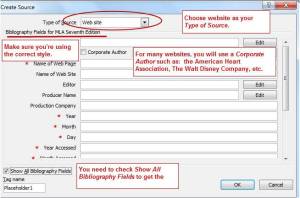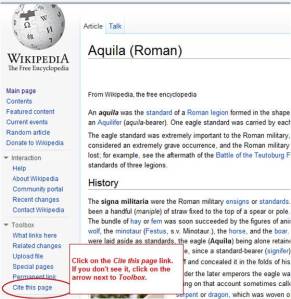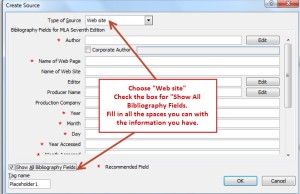Citing web sources is just as difficult as determining what kind of source you have. The problems are related. You need to know the type of source to cite it correctly.
Adding to the confusion is the fact that there are no official format styles for many types of web sources. How do you figure out how to cite them?
Start with checking the official style manual for the format you are using (MLA, APA, Chicago/Turabian). If you don’t find what you need, try the OWL@Purdue list of examples. They will give you a reasonable suggestion and explain why they formatted citations as they did. If you don’t find what you’re looking for, either use the OWL search box (for example: APA YouTube) or scan the OWL’s FAQs to find their suggestions for formatting: MLA, APA. Check out the University of Chicago Press website for information on Chicago/Turabian.
Still don’t see what you need? Try a Google (or Bing, etc.) search (for example, if you want to cite a tumblr: APA 6th tumblr library OR MLA 7th tumblr site:edu). Adding in the word “library” or searching only .edu sites will help you find the best guides. Libraries and writing centers have the best guides. Be sure the guide is for Chicago 16th/Turabian 8th, MLA 7th edition and APA 6th edition. An even better way of vvvvvvvv
Remember! Do not reference an entire website unless you’re using it as an example.
NOTE: If your instructor wants a different version of Chicago/Turabian, APA or MLA, use that version.
Remember that in a real bibliography/reference list/ worked cited list, you would indent the second and any following lines. Note that the title of website is in italics.
The publisher can also be referred to as the sponsor or sponsoring group or a corporate author (=an association, government agency, etc., cited as an author). So, for the National Geographic citations, National Geographic is both the title of the website and the publisher/sponsoring group/corporate author.
Chicago 16th/Turabian 8th
Author. “Title of webpage.” Title of the Website, if no title, publisher of website. Date of publication. Accessed date. URL.
Hawass, Zahi. “King Tut’s Family Secrets.” National Geographic. National Geographic, Sept. 2010. Accessed April 5, 2015. http://ngm.nationalgeographic.com/2010/09/tut-dna/hawass-text
Author. “Title of webpage.” Title of the Website. Publisher Name, Day Mon. Year. Web. Day Mon. Year retrieved.
Hawass, Zahi. “King Tut’s Family Secrets.” National Geographic. National Geographic Society, Sept. 2010. Web. 19 Apr. 2015.
APA 6th edition
Author. (Year, Month day). Title of webpage. Title of the Website. Retrieved from URL of specific article
Hawass, Z. (2010, September). King Tut’s family secrets. National Geographic. Retrieved from http://ngm.nationalgeographic.com/2010/09/tut-dna/hawass-text
NOTE: Don’t have an author? Start with the title (King Tut’s…). For APA, put the title followed by a period THEN put the date information in parentheses. Never start with the date.
Using Word to cite pages from general websites. (Click to enlarge image.)
NOTE: Using Word 2013 or 365? You don’t need to click on the “Show all Bibliography Fields” box. All fields are available.
Citing other web sources
Wikipedia makes it easy for you. Once you’ve chosen a good article that you are allowed to use, then use their cite tool.
Blogs, newsgroups, Tumblr, forums, etc.
Turabian 8th edition
Author or screen name. “Title of Post.” Name of Site. Date of post. Accessed date. URL.
Prain, Leanne. “Interview with the Knitorious M.E.G.” Yarn Bombing: Improving the Urban Landscape One Stitch at a Time. June 2, 2010. Accessed March 12, 2012. http://yarnbombing.com/?s=knitorious+m.e.g.
NOTE: some guides (and instructors) recommend using the format type after the title UNLESS the format word appears in the title. Some put it in parentheses, others do not. I personally leave it out, but check with your instructor.
Example: Prain, Leanne. “Interview with the Knitorious M.E.G.” Yarn Bombing: Improving the Urban Landscape One Stitch at a Time. (Blog). June 2, 2010. Accessed March 12, 2012. http://yarnbombing.com/?s=knitorious+m.e.g.
OR
Example: Prain, Leanne. “Interview with the Knitorious M.E.G.” Yarn Bombing: Improving the Urban Landscape One Stitch at a Time. blog. June 2, 2010. Accessed March 12, 2012. http://yarnbombing.com/?s=knitorious+m.e.g.
MLA 7th edition
Author or screen name. “Title of Post.” Name of Site. Message number if available. Name of Sponsor or publisher, Day Mon. Year posted. Web. Day Mon. Year retrieved.
Prain, Leanne. “Interview with the Knitorious M.E.G.” Yarn Bombing: Improving the Urban Landscape One Stitch at a Time. Yarnbombing. 2 Jun. 2010. Web. 12 Mar. 2012.
NOTE: I had really to search to find the author’s name and the posting date. If you use web sources, you’re expected to do the same. If you don’t want the hassle of figuring out how to cite web sources, then stick with articles from library databases.
Message numbers were more common in listservs, forums, and similar, older systems.
APA 6th edition
Author or screen name. (Year, Month day). Title of post. [Web log post]. Retrieved from URL of specific post
Prain, L. (2010, June 2). Interview with the Knitorious M.E.G . [Web log post]. Retrieved from http://yarnbombing.com/?s=knitorious+m.e.g
NOTE: The blog cited above is a good example of why a “date accessed” is helpful. In 2012, the post was available. It is no longer available from the blog. You might be able to find it using The Wayback Machine. (You can check out Knitorious M.E.G. at her website: http://knitoriousmeg.com/)
Citing YouTube and other web videos
Turabian 8th edition
Author or screen name. “Title of Video.” YouTube. Date posted. Accessed date. URL of specific video.
- If there’s no author/screen name posted, start with the title.
- If there’s no date created, use copyright date if available OR use: n.d. for no date.
TheKheinz. “JK Wedding Entrance Dance.” YouTube. July 19, 2009. Accessed March 12, 2012. http://www.youtube.com/watch?v=4-94JhLEiN0.
MLA 7th edition
Author or screen name. “Title of Video.” Name of Channel or Episode if Available. Name of Website. Name of Sponsor or publisher, Day Mon. Year created. Web. Day Mon. Year retrieved.
- If there’s no author/screen name posted, start with the title.
- If there’s no date created, use copyright date if available OR use: n.d. for no date.
- If there’s no obvious channel or episode, leave it out.
TheKheinz. “JK Wedding Entrance Dance.” YouTube. 19 Jul. 2009. Web. 12 Mar. 2012.
APA 6th edition
Author or screen name. (Year, Month day). Title of video. [Video file]. Retrieved from URL of specific video
- If there’s no author or screen name, start with the title of video THEN the date
TheKheinz. (2009, July 19). JK wedding entrance dance. [Video file]. Retrieved from http://www.youtube.com/watch?v=4-94JhLEiN0
Remember – if the citation for a bibliography/reference/works cited list is more than one line, indent the second – and any following – line 5 spaces.
Using Word to cite web sources
General Word format for other web sources.
Courtesy of Microsoft




